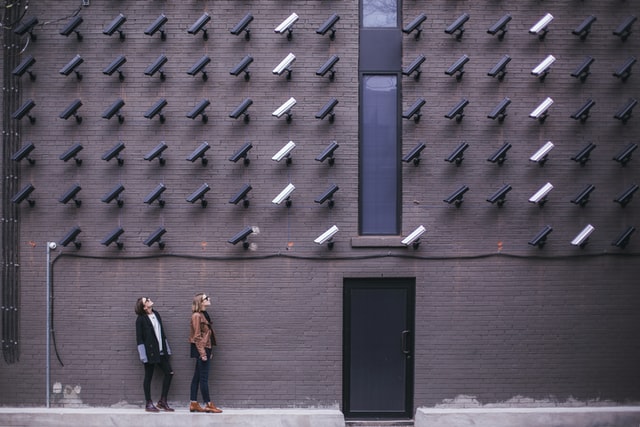
Photo: Matthew Henry on Unsplash
Can signage build trust in how cities use technology and data?
13 June 2023
by Sarah Wray
The ‘smart city’ has lost something of its lustre, with city officials increasingly saying the term lacks specificity, while concerned residents often equate it with surveillance.
“I personally don’t like the name smart cities,” says Mike Melinyshyn, Chief Financial Officer and Director of Corporate Service and Innovation for the Town of Innisfil, Canada. “I’ve reframed it as ‘insightful’ and what I am trying to create is an insightful Innisfil.”
By this he means using technology, especially the Internet of Things, to gather data and use analytics to become “insightful” and improve quality of life, while maintaining privacy.
“There’s nothing smart about intrusive, invasive technologies,” Melinyshyn comments.
Alongside Angers-Loire Metropolitan Region in France, and Boston and Washington, DC in the US, Innisfil recently completed a trial of new signage which aims to address some of the issues related to using data-gathering technology in public spaces.
The pilot comes as cities are increasingly deploying technology such as sensors and cameras for transport management, public safety, and environmental improvement.
Residents and community groups often have legitimate concerns about the impact on their privacy and use of public money. In other cases, misinformation, misunderstanding or lack of any substantial information at all can cause fear around technology.
This has highlighted a growing need for better communication about these often-invisible systems and what they do – as well as what they don’t.
The Digital Trust for Places and Routines (DTPR) open-source communication standard aims to increase transparency about technology in public spaces and provide a consistent visual language and feedback mechanism.
It incorporates a taxonomy of concepts around digital technology and data, and a set of icons to communicate them through physical signage and online. For example, the icons show who is accountable for the technology, its purpose, and how data is processed and stored.
The DTPR was initiated by Google’s Sidewalk Labs in 2019 during the now-abandoned plan to create a high-tech neighbourhood in Toronto’s Quayside district. Sidewalk Labs cited “unprecedented economic uncertainty” when it dropped out in May 2020 but had also faced criticism and accusations of “surveillance capitalism”.
The DTPR standard is now stewarded by start-up Helpful Places, which offers a software platform as well as consultancy services to support adoption of DTPR.
Jacqueline Lu, President and Co-Founder of Helpful Places, comments: “I think when we’re talking about IoT, what is missing is that people can see that there’s data collection, you can see that you are being measured in some way just through the presence of a camera, but what’s much harder to get at is what the benefit is because you don’t know who’s there or who put it there.”
Lu was formerly the Director of Digital Integration at Sidewalk Labs and was also the founding Director of Data Analytics at the NYC Parks Department.
“I see DTPR as a mechanism to help raise the awareness that is critical to being able to actually unlock a dialogue between governments and technology vendors and members of the public about how these technologies could be used,” she says.

Pilot results
In the pilots, the local governments displayed signage at specific locations where technology was being used, including a QR code and web link for more information. They also gathered feedback from residents on the signage via emoji responses and longer surveys, as well as field interviews.
Across the four projects, 48 signs were deployed representing 13 different technologies and almost 1,400 people engaged with the signage through the QR codes, according to a report on the pilots from Helpful Places.

Innisfil is a small town of around 43,000 people near Toronto, but it has big ambitions when it comes to innovation. The town notably doesn’t own any buses and instead uses Uber as its public transport system. It is planning to develop a futuristic, high-density community called The Orbit, centred around a new Go transit station. The development aims to mitigate urban sprawl and be a place where “technology makes life easier”.
“So we’re now using the rest of Innisfil, to trial some of these things,” says Melinyshyn.
Innisfil selected smart garbage cans in two parks for its DTPR pilot, deploying four signs in total. The new waste bins are partially around 10 feet underground and include sensors to measure when the bin is full to improve pick-up schedules and maintenance.
Although the trial was on a small scale, Melinyshyn believes it was a success “100 percent”, particularly from the perspectives of public notice and getting resident feedback.
Around 78 people interacted with the signage with roughly a quarter of those drilling down into the app for more information or to provide feedback. There were also around 17 on-site surveys.
“Almost all the residents were very happy that we’re using the technology,” says Melinyshyn. “People were really excited about the technology, and really interested in it.”
The DTPR could be used more widely in Innisfil to provide information about public Wi-Fi and other new technologies, such as flooding sensors.
“It’s that essential socialisation of the use of technology,” says Melinyshyn, adding that the more residents see the signs and QR codes, the more likely they are to feel the town is being open about technology.
“That’s ultimately where I want to get to,” he says.
Challenging assumptions
Washington, DC used the DTPR signage to raise awareness of three of the emerging technologies it is using in its Pedestrian and Cyclist Intersection Safety Sandbox research project.
The technologies installed at a handful of intersections use computer vision to provide information such as the number of vehicles, pedestrians and cyclists at each location, as well as how often there are incidents of speeding and near-misses. In total, 16 signs were installed.

“I do think it was a success,” says Stephanie Dock, who manages the innovation division at the District Department of Transportation.
In feedback, people generally said the information was easy to find. There were some negative comments on how the technology made people feel, but sentiment was mostly positive. The findings on whether people found the information easy to understand were mixed but overall, people did seem to find the DTPR information helpful, according to Dock.
She says the department often receives questions from the public and the media when something new is deployed. In other cases, the technologies are barely visible and may go unnoticed.

“It was a first real attempt for us to put it out to the public what we were doing in a way that wasn’t just a project website and having to go to community meetings,” Dock comments, adding that while residents likely have some expectation of a certain amount of surveillance in public spaces, it’s important to make clear the purpose of various systems.
“I think it can also help tell our story of the good things that we are doing,” she says, giving the example of specifying that a camera is monitoring traffic and not recording faces.
“Being able to talk about that allows the public to engage in the conversation in a way that is much more productive than just assuming that we’re not doing anything or assuming nefarious intent.”
She said the signage may be used as other technologies are piloted, including for drones.
A sense of purpose
Boston was the first city to pilot the DTPR in 2020 with a focus on traffic sensors, later adding de-identified video analytics and air quality monitors. The pilots were managed by the Mayor’s Office of New Urban Mechanics which experiments with and evaluates new approaches in the city.
Yo Deshpande, Technologist for the Public Realm, said that the team had undertaken surveys through the QR code and interviews.

“People really liked the look of the icons; the visual style is attractive to people and people prefer them to other kinds of city messaging,” says Deshpande. “People are more likely to linger when engaging with the signs.”
Deshpande said the feedback also showed that “[people] appreciate the effort at transparency. They do feel like it’s a different sort of approach, that the city is being more proactive and transparent.”
Boston intends to continue using the signs and looking at how they could be expanded out to other kinds of technology around the city.
There were other takeaways from the pilots too.
In the first phase, Boston used stickers but they struggled to survive the weather and were swapped for metal signs.
Deshpande said a key learning was that people feel “unsatisfied” when the QR code links to information about the sensor or the technology only, because they want information on the wider context of how it relates to their life and could improve it.
The pilot also highlighted that people want a consistent way to engage with and use the data produced by the sensors. This spurred the city to create public dashboards for the air quality data, for example.
Procurement
As well as improving resident engagement, the participating governments said that the DTPR pilots had important internal benefits too.
Dock explains: “Having DTPR causing us to ask questions was very helpful in talking to the vendors. It gave us a guide to some of the questions that we maybe knew we wanted to ask but didn’t know quite the right way, or hadn’t fully dug into.”
Deshpande says the DTPR has been helpful in organising information from vendors and the team is exploring creating guidelines and templates for vendor agreements to ensure clarity on data retention and deletion and third-party assets.
Innisfil is also evolving its procurement processes based on learnings from the pilot to ensure privacy and transparency requirements are clearly defined.
Melinyshyn says it’s important to get the information “upfront”.
“So we’re not chasing them afterwards. If they don’t want to give it to us, we don’t want to do business with them.”
Lu notes that beneath the iconography, DTPR is also a data standard and a common language and this helped “demystify” projects internally as well as with the public – including for customer service and communications staff who may receive questions but are not technology experts.
Normalising surveillance?
Andrew Clement, Professor Emeritus in the Faculty of Information at the University of Toronto, was a member of Waterfront Toronto’s Digital Strategy Advisory Panel for the Sidewalk Labs Quayside project.
He says he is not against surveillance per se, but stresses the importance of accountability.
Around a decade ago, he designed prototype signage to denote the presence of CCTV cameras after finding that many deployments in major metropolitan areas in Canada did not comply with minimum privacy guidelines, including displaying adequate signage.

He went on to offer 100 Canadian dollars to anyone who could show him a business-operated surveillance camera that met these requirements.
“I’ve still got the $100 in my back pocket,” he says.
For Clement, many aspects of the DTPR are positive but he still has some of the same concerns he had when the system was thought up at Sidewalk Labs.
One is around sensitivity of information. In the DTPR taxonomy, a yellow hexagon indicates identifiable information and blue highlights de-identified.
Clement suggests introducing the colour red for the most sensitive applications, including facial recognition.
“When it gets into surveillance when personal information and rights are involved, I think they need to be much more forthcoming,” he says, adding that where relevant the top-level signage should outline the legal authority to collect information, identify the operator and provide direct contact details – ideally a phone number.
“I mean, how often do you use QR codes?” he says.
He is also concerned about the “normalisation” of surveillance.
“[Signage] can normalise surveillance in a way that people take for granted that our environments are saturated with surveillance devices and that’s what cities are – and your attention is not drawn to the ones that are really important. That’s why I would like to see use of red for instance.”
Lu argues that technology and surveillance are already widespread in cities. “We are creating a way for the public to be able to read the space and know what is there and then facilitate creating avenues for dialogue and comment that honestly don’t exist today,” she comments.
Where next?
As the pilots draw to a close, many questions remain: What is the lifecycle of a DTPR sign? When should new icons and technologies be added and who decides? What is the balance between detail and useability? When should a sign be deployed? Should cities have signage for any and all sensors and related technologies?
Another open question is whether DTPR signs in one scenario could create the expectation that all technology will be denoted in the same way – if this is unmet, the endeavour could look like ‘ethics theatre’ and trust could be further eroded.
Melinyshyn thinks all technologies that collect data in public space should have signage for transparency, while Dock sees potential for challenges, particularly in areas where there is a lot of technology or multi-purpose systems such as cameras with analytics. One of DC’s DTPR signs that saw less interaction was in an area where there was also a lot of political and other signage.

According to Clement, cities should start where people’s rights are implicated and where the operator has responsibilities to obey the law. “Then there will be fewer signs,” he says.
The Angers Loire deployment demonstrated usage of the signs for multiple technologies in a single place, covering public Wi-Fi, cameras, parking sensors, smart bins and streetlighting controls in the Place de la Fraternité.
Lu says in a scenario like this, cities could potentially add signs on all sensors as an introductory measure, before reducing this later to only at entrances.
She is open about the fact that the DTPR is “just the start of the journey” and is intended to work in concert with the development of broader governance and policies.
Cities such as Oakland and San Diego have implemented surveillance technology ordinances and privacy boards, and Amsterdam has an online sensor registry.
DTPR is now also being trialled in Long Beach and Sydney Olympic Park.
Lu says: “The biggest part of this experiment was to see whether carrying out these pilots and sharing their stories would help us understand whether there is demand for DTPR. We believe there is and it’s not just an idea now; it’s something that’s come out into the real world and it’s intended to evolve.”
Helpful Places is developing a governance framework for the evolution of the DTPR and launching a Community of Practice for municipalities that have implemented the standard.
Several Dutch cities are also developing a national standard to inform residents about the use of sensors, aiming for it to be broadly recognised in the same way as road signs.











